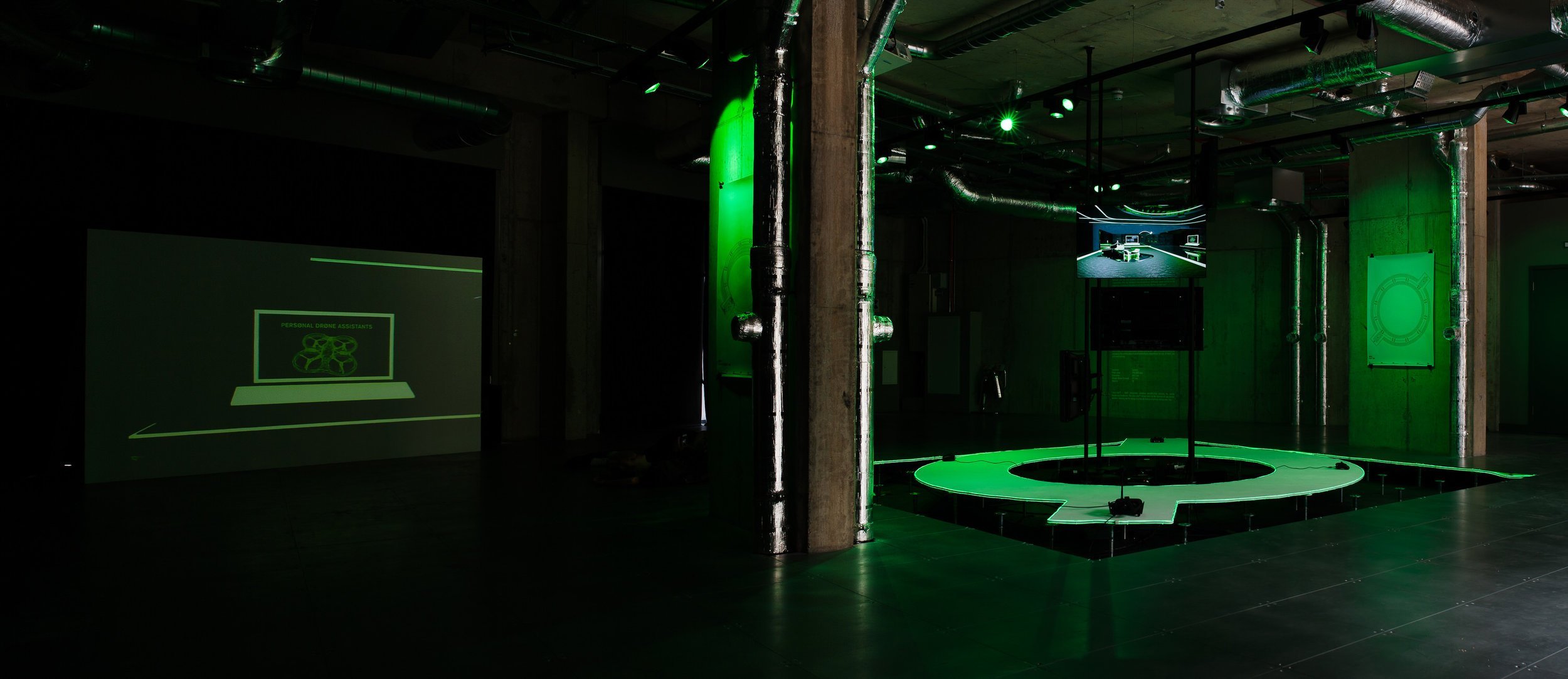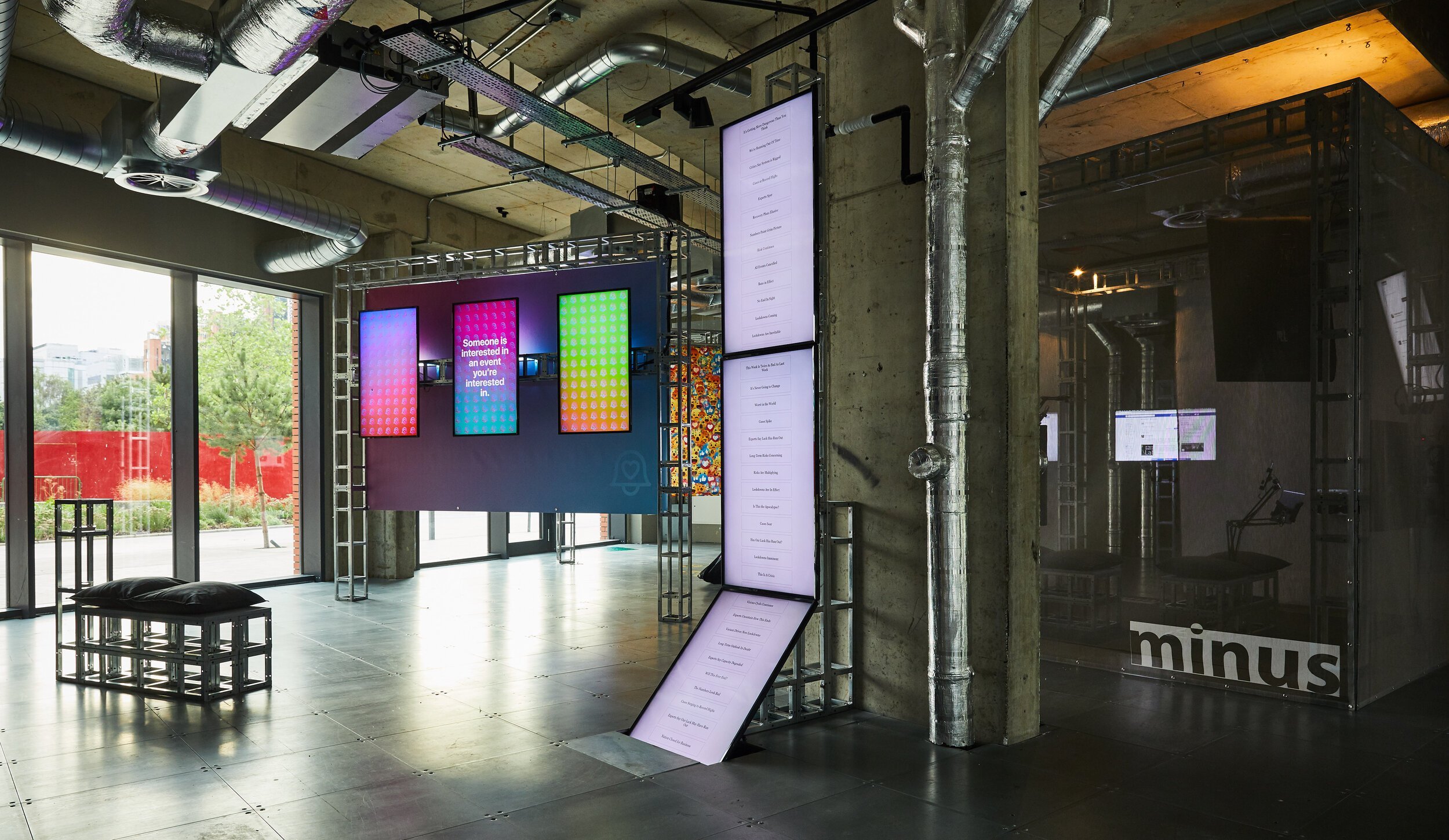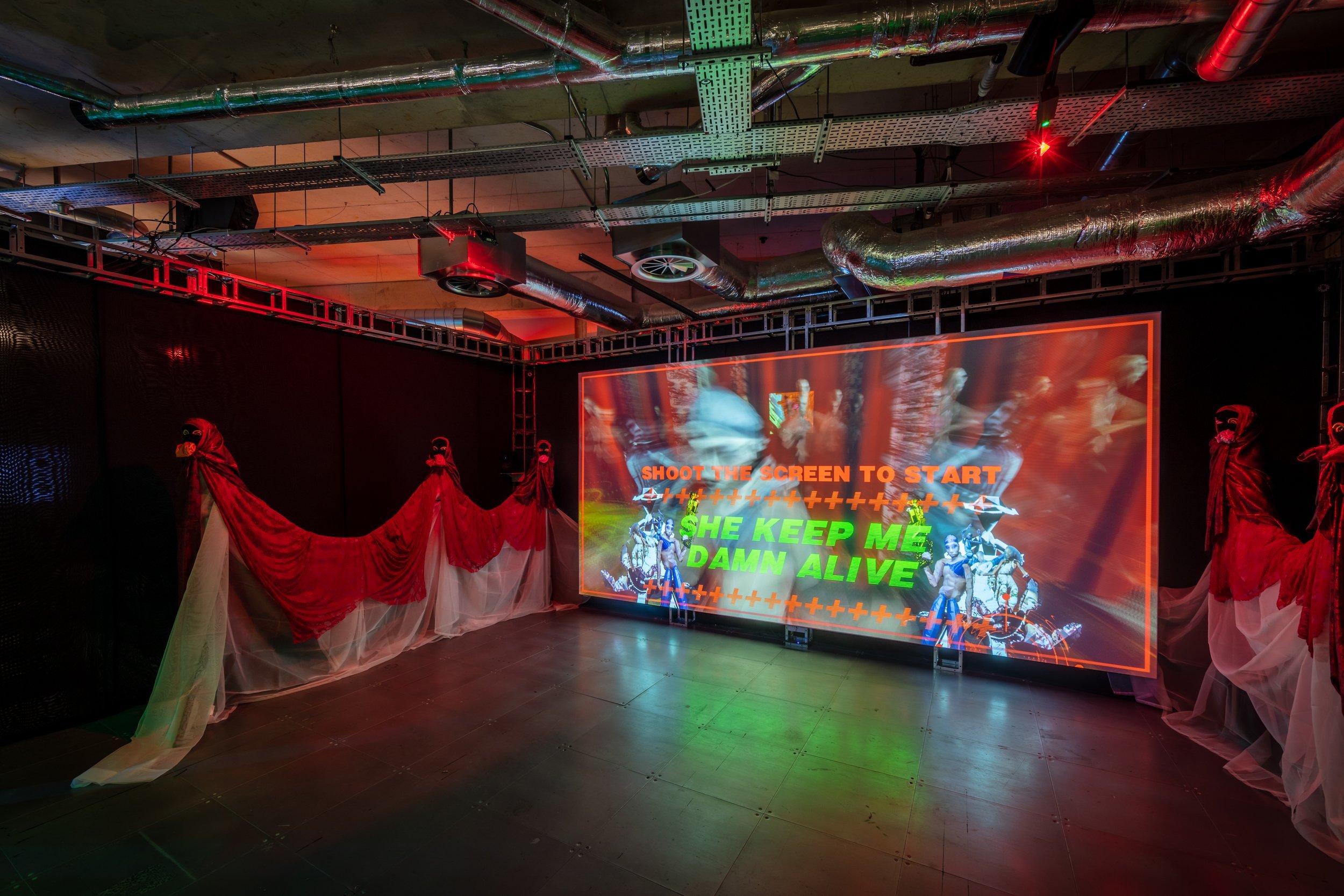arebyte 2023 - 2026 Programme
For its 10th anniversary, arebyte embarks on a three-year artistic programme that surveys the complex nature of humanity in the realm of technological progression. Entitled The Body, The Mind, The Soul, the programme explores the human condition, reflecting on the nuance of individual and collective existence within the changing world that now shapes us. Delving into the depths of these three aspects of being, exploring their convergence with digital technology and the myriad ways they shape our experiences, the programme hopes to shed light on artistic practices influenced by bodily and disembodied thinking.
Taking a contemplative and philosophical approach spanning the broad sweep of human existence, the body, the mind, and the soul hold the key to enriching our lives and fostering a path for deeper connections with ourselves and everything in the world around us. Each term, whether explored individually or in conjunction with another, has been discussed extensively in Western and Eastern philosophy and also intersects with technology and art contexts. The terms can be addressed in different ways depending on perspective, privilege, cultural meaning, and experience. By questioning the intricate dynamics between our bodies, minds, and souls, we not only gain insight into the human condition but also broaden our perspectives, embracing and harnessing the unquestionable potentials of the digital realm.
Through exhibitions, events, and educational initiatives, The Body, The Mind, The Soul examines how technological advancements – particularly in the digital realm – influence our understanding of human and non-human bodies in the present age. Investigating the far reaches and limitations of our intelligence, the programme considers the significance of the mind, the body and the soul in the context of a digital existence beyond our physical lives, through the works of visionaries who challenge conventional wisdom and probe the deepest recesses of our beings. Artists and contributors to the programme draw inspiration from the transformative power of digital technology to create space for reflection and dialogue in a rapidly changing digital landscapes. Our collective journey through these artistic explorations invites us to reevaluate our relationship with technology, its impact on our understandings of ourselves, and our places in the world.
Artists
Rebecca Allen
Péter Bergmann
Ursula Bieman
Zach Blas
Anna Bunting-Branch
César Chirinos
Crosslucid
Patricia Domínguez
XU Haomin
Concepción Huerta
Damara Inglês
Dian Joy
Choy Ka Fai
Andrea Khora
Katarzyna Krakowiak
Avinash Kumar
Lawrence Lek
April Lin
Sebastián Mira
Sri Rama Murthy (aka Murthovic)
Mónica Nepote
Vica Pacheco
Iris Xiaoyu QU
Rebeca Romero
Kinnari Saraiya
Ruini Shi
Ricardo Sierra
Maria Thuy Hien Than
Suzanne Treister
Flavia Visconte
Kira Xonorika
Guest Curators
Helen Starr
David Blandy
Doreen E. Rios
Jamie Sutcliffe
BI Xin 毕昕
Speakers and Contributors
Cameron Aubernon
Catherine Bird
Dr. Hernando Chindoy Chindoy
Alya Kanibelli
Andrea Khora
Helen Knowles
Philip Speakman
Gunseli Yalcinkaya
Workshop Leaders
Angela YT Chan
James Irwin
James B. Stringer
Shinji Toya
Tanya Boyarkina (compiler)
David Blandy
Robert Hall
Partners
Antimateria
Chronus Art Centre
Knowle West Media Centre
ELAM
FACT
G39
King’s College London
Mediale
National Videogame Museum
NEoN
Northumbria University
Phoenix
QUAD
Strange Attractor Press
New Media Scotland
Sirlute
UCL, BA Digital Media
Interface Between Physicality and Virtuality
In the era of digital advancements, our bodies have become conduits for technology, augmenting our capabilities and experiences with varying transportative tools and models.
As we grow increasingly intimate with technology, our relationships with screens, artificial intelligences and machines evolve to reshape our perspectives of the world and assist us in understanding the juxtaposition/symbiosis at play with the physical and virtual.
With heightened intimacy comes increased empathy with technologies; technologies that are being used as testing grounds, sandboxes and virtual possibility machines. This critical play is seen in the symposium with artist David Blandy and writer, curator, and co-director of Strange Attractor Press Jamie Sutcliffe (Areas Of Effect: Planar Systems, Critical Roles, and Gaming Imaginaries, 2023), which looks at tabletop role-play as a transformative activity.
The Body - Looking back at the work of alumni artists
This expression of empathy and understanding of technology from a bodily and immersive perspective was seen in Alan Warburton’s expanded video essay (RGBFAQ, 2020), through large-scale projection mapping and human-proportioned sculptures.
Installation view of RGBFAQ, Alan Warburton, 2020, arebyte Gallery, London. Photo: Max Colson
The language surrounding terms like “cyborgian” is also challenged as our smart devices become permanent appendages of our arms. Other links to this interplay are promoted by embedded wearables and body modifications that extend our sensory perception, allowing us to interact with the world in novel ways, as seen in the works of pioneering artists like Choy Ka Fai (The Choreography of Things, 2014) and Marco Donnarumma (Humane Methods [℧R], 2022). These artists have critically examined the boundaries between humans and machines, and they continue to challenge our understanding of the physical self and the potentialities of integration with machines and hardware.
The expansion of our virtual self and its relation with our physical being propose new forms of intimacy and relations and are exemplified in the works of artists like La Turbo Avedon (Re-Figure Ground, 2019/Club Zero, 2022) and Abi Sheng (FUTURES PAST, 2022), who explore the interplay between the human body and its digital avatar or counterpart.
Immersive and experiential artworks that traverse the physical and virtual realms, such as those created by Lawrence Lek (Nøtel, 2018/FUTURES PAST, 2022), Olia Lialina (Best Effort Network, 2020) and Libby Heaney (The Evolution of Ent-: QX, 2022), further entwine our existence with digital technology.
Installation view of Nøtel, Lawrence Lek, 2018 arebyte Gallery, London. Photo: Luka Radek
Digitalisation of Consciousness
Our minds meld with emerging digital technologies such as biotechnology, robotics, blockchains and artificial intelligence, alongside a technology that is more aligned with immaterial, spiritual transcendence and neo-communication. These are technologies of the mind that enhance cognitive abilities, learning, or mental well-being such as neurofeedback, nootropics, meditation and hallucinogens. This can be seen in the work of Zach Blas (CULTUS, 2023) whose work shares belief systems via a techno-religious computational device artificial intelligence is imbued with godly power.
Human consciousness becomes intertwined with the digital and ethereal realm, leaving an indelible mark on the way we perceive, structure and verbalise inner reasoning. In the screening and panel conversation co-curated with Helen Knowles (Towards a Cosmotechnic Psychedelia, 2023), featuring film works by Suzanne Treister and Patricia Domínguez and others, we see this technological network play out through embodied experience, techno-spiritual renderings and narrative-building beyond sentience.
The Mind - Looking back at the work of alumni artists
For artists like Mark Farid (Seeing I, 2019) and Sarah Selby (Raised by Google, 2019), who interrogate the relationships between human and digital consciousness, the mind is examined as a computational tool for connection and information dissemination. The realm of machine learning and artificial intelligence, as seen in the works of Ben Grosser (Software For Less, 2021) invites us to question the nature and production of knowledge itself, the ghost in the machine, while also playfully hacking systems and attempting to confound the subjugation of big tech.
Installation view of Software For Less, Ben Grosser, 2021, arebyte Gallery, London. Photo: Max Colson
Our perceptions of reality and the self are increasingly influenced, subtly modified and overtly conditioned by digital technology. Whether through hardware and tools like smart devices, implantable brain/computer devices or other wearable monitoring technologies, our behavioural traits, and in essence our consciousness, are offered up for use by technocratic companies in ways that can be deemed behaviourally capitalist. We can say the same for software and community services like social media platforms, health monitoring apps, and data-based and behavioural marketing strategies, as seen in works by artists such as Ami Clarke (The Underlying 2019) and Louise Ashcroft (I’d Rather Be Shopping, 2017). Mental health and awareness, care through talking practices, and the function of medication and meditation are prominent in this evolving landscape. Whether as individuals or as collectives, the role of physical and digital support systems and digital escapism tactics is more important than ever. Artists such as Kate Frances Lingard (tender spots in hard code, 2021) and Danielle Brathwaite-Shirley (She Keeps Me Damn Alive, 2021) address these themes while exploring the power of action, networks and resistance to encourage a sense of collectivity through compassion and shared accountability. The coding and programming of the mind are evident in the networked infrastructures we inhabit, as are the lessons gleaned from queer, migrant, crip, and anti-colonial solidarity movements that inspire alternative visions of our digital futures.
Installation view of She Keeps Me Damn Alive, Danielle Brathwaite-Shirley, 2021, arebyte Gallery, London. Photo: Dan Weil
Ethereal Essence Beyond Physicality
As we venture into the realm of the soul, we delve into the ethereal essence that transcends our physical and subjective existence. The immaterial aspects of the soul and its existence outside of consciousness, minds and our physical bodies form the essence of a person, encapsulating memory, nostalgia, mythologies, identity, and personality that survive beyond our corporeal forms. Through artistic endeavours, we are invited to question the relationships between our physical selves, our digital identities, and the enduring nature of our souls.
This exploration of the soul is grounded in the rich history of philosophical and religious inquiry, and is brought to life by the creative expressions of contemporary digital artists such as Zach Blas (CULTUS, 2023), Kira Xonorika, Ricardo Sierra and others in their online exhibition with Doreen A. Rios (Minimal Rituals, 2023).
The Soul - Looking back at the work of alumni artists
Digital technology's impact on our concept of the soul is profound. From eternal living and achieving immortality through digital advancements to the exploration of the limits of human existence in the face of death, artists such as Zoe Hough (The Microbial Verdict, 2015) challenge our meaning of the soul in a technologically-driven world. The idea of the soul as a philosophical question transcends time and space, leading us to contemplate our bodies and minds, sins and redemption, afterlives, and reincarnation in the context of our digital and virtual selves.
Installation view of The Microbial Verdict, Zoe Hough, 2015, arebyte Gallery, London.
Installation view of Satellite Devotion, Tabita Rezaire, 2019, arebyte Gallery, London. Image: Christopher MacInnes











